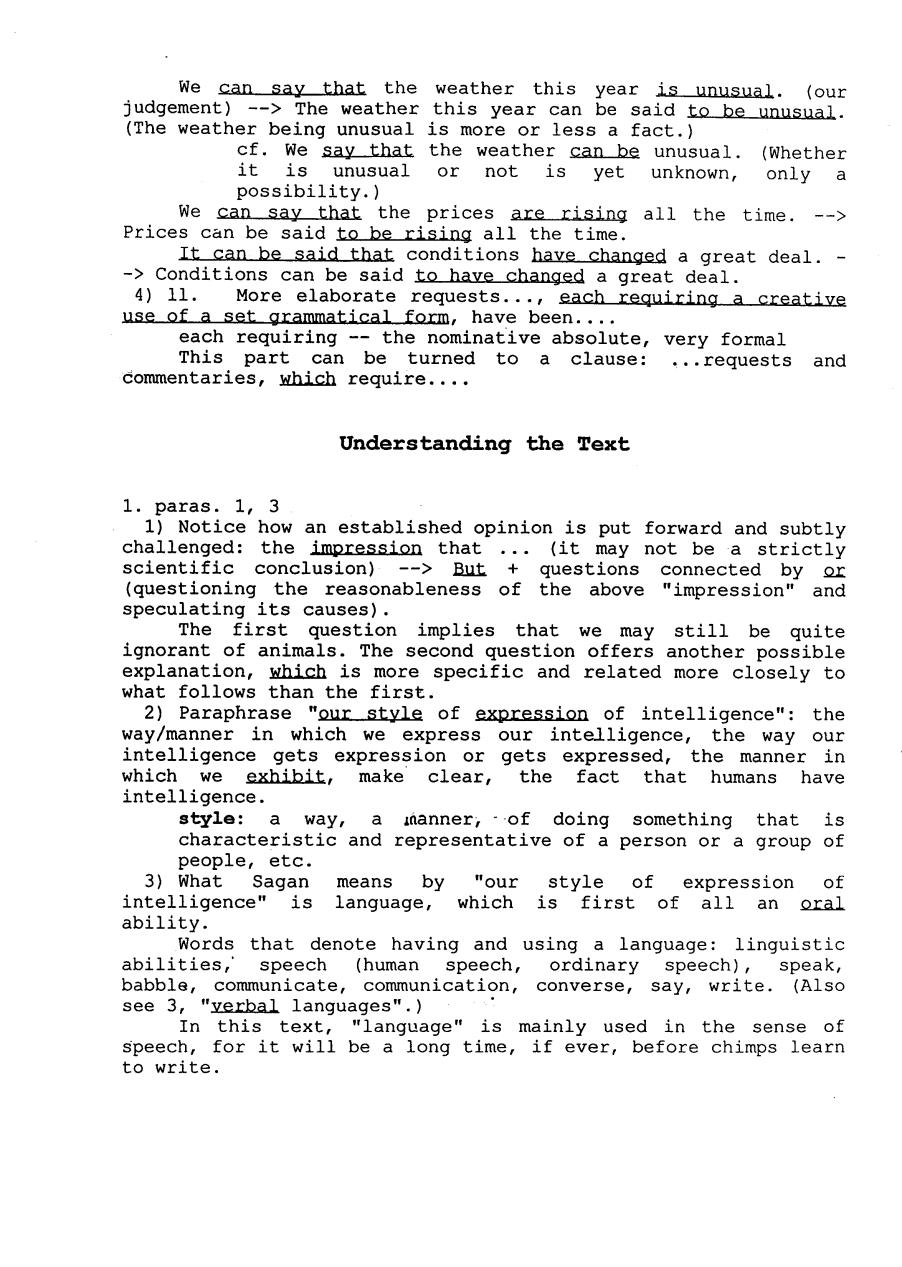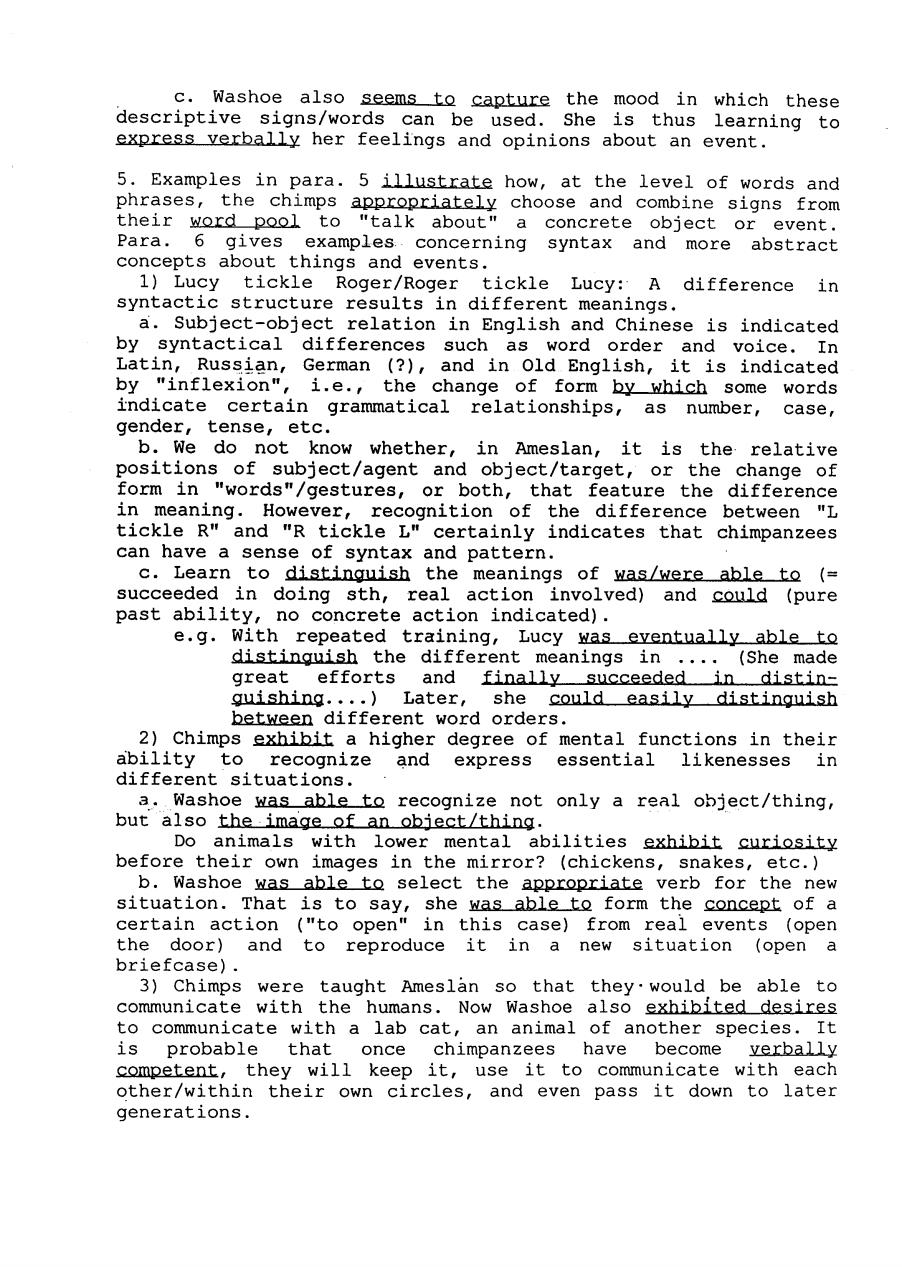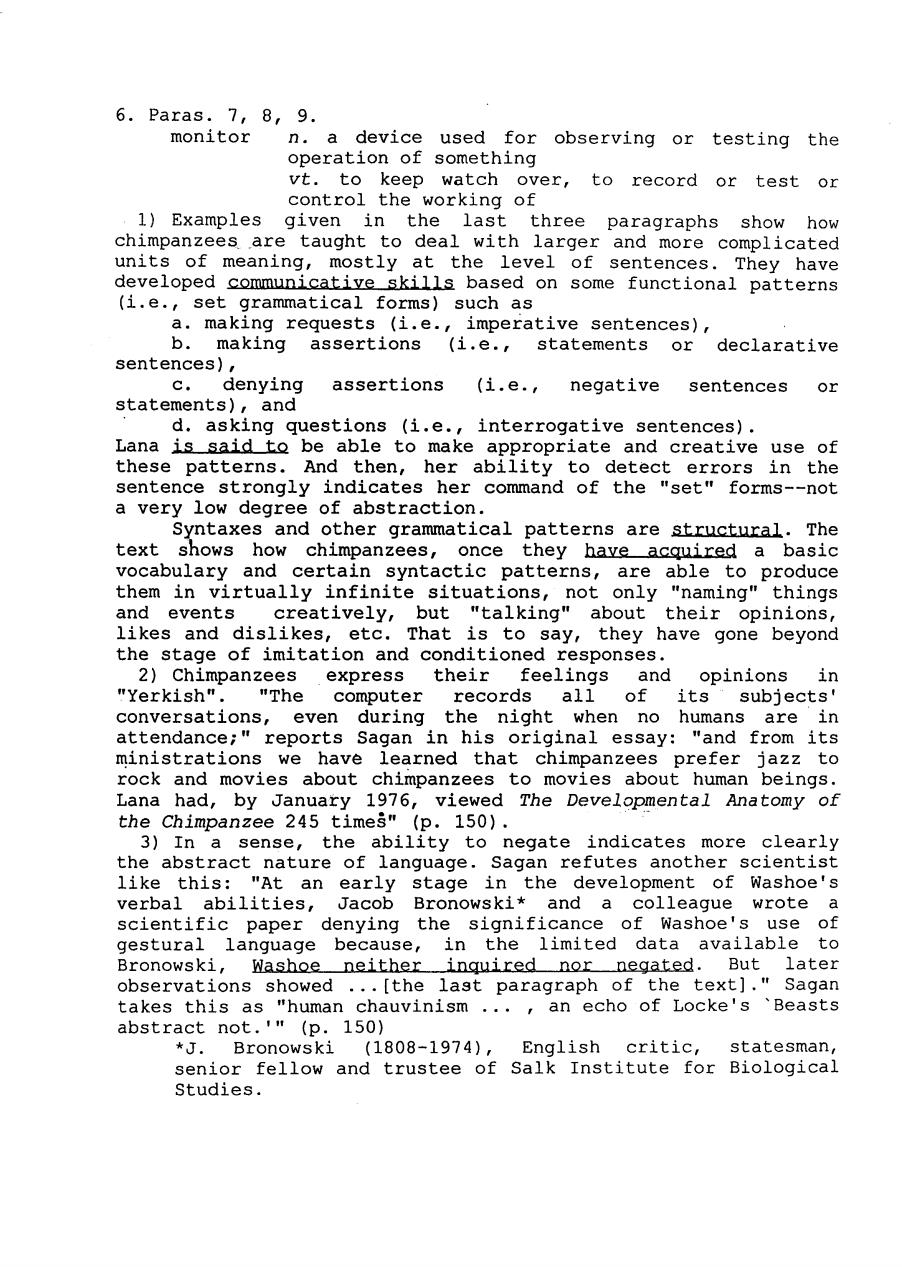
We can say that the weather this year is unusual.(our judgement)-->The weather this year can be said to be unusual. (The weather being unusual is more or less a fact. cf.We say that the weather can be unusual.(Whether it is unusual or not is yet unknown,only a possibility. We can say that the prices are rising all the time.-- Prices can be said to be rising all the time. It can be said that conditions have changed a great deal. -Conditions can be said to have changed a great deal. 4)11.More elaborate requests...,each requiring a creative use of a set grammatical form,have been.... each requiring -the nominative absolute,very formal This part can be turned to a clause:...requests and commentaries,which require.... Understanding the Text 1.paras.1,3 1)Notice how an established opinion is put forward and subtly challenged:the impression that ..(it may not be a strictly scientific conclusion)-->But questions connected by or (questioning the reasonableness of the above "impression"and speculating its causes). The first question implies that we may still be quite ignorant of animals.The second question offers another possible explanation,which is more specific and related more closely to what follows than the first. 2)Paraphrase "our style of expression of intelligence":the way/manner in which we express our intelligence,the way our intelligence gets expression or gets expressed,the manner in which we exhibit,make clear,the fact that humans have intelligence. style:a way,a manner,of doing something that is characteristic and representative of a person or a group of people,etc. 3)What Sagan means by "our style of expression of intelligence"is language,which is first of all an oral ability. Words that denote having and using a language:linguistic abilities,speech (human speech,ordinary speech),speak, babble,communicate,communication,converse,say,write.(Also see 3,"yerbal languages".) In this text,"language"is mainly used in the sense of speech,for it will be a long time,if ever,before chimps learn to write

Sagan implies that there may exist styles/ways other than ours /other styles/ways than ours of expressing intelligence, and that "language"may not be entirely the same thing as speech. 4)"recent evolution":See above,Note No.4.Ask the students:Has it ever occurred to you that human language may have been accidental in the evolutionary history? 2.para.2 1)One of the purposes of such experiments was to see if a baby chimp was able to acquire human language (English,in this case)when it was raised with a human baby as twins in an entirely human environment. 2)The chimp exhibited excellent motor skills,which were much less developed in the human baby.Yet it was almost beyond the chimp ever to acquire the ability to speak through the.mouth while oral speech came so naturally to the human baby. motor adj.giving or producing motion motor neryes:nerves that carry impulses from the brain,etc.to the muscles motor skills:abilities of/related to nerves that cause muscles to move 3)Perhaps experiments of this kind proved to most people that a chimp was a chimp and a human was a human.It is a deep-rooted belief that having language or not distinguishes humans from animals (See above,Note No.4,about "language"and "tongue"), for only in language can we think abstractly.For centuries, people have (all too easily)taken linguistic abilities as evidence/a sign of the presence of intelligence,and thus dismissed animals as lacking reason. *Questions Nos.7 and 8 will further deal with language, abstraction and "other higher mental functions". 3.1)Ameslan is a North American sign language for the deaf and dumb,that is,for those unable to "speak"(English). 2)a.The Gardners certainly believed that the chimps were intelligent animals;b.They reasoned that chimps had substantial language abilities which could not be expressed by the mouth because of the limitations of their anatomy (Norton, p.148);c.Compared with human beings,chimps are immensely capable in manual skills;d.As Ameslan also demands a skillful use of the hands,it may be much easier for chimps to learn. 3)yerbal languages (1.)Here,"spoken"languages,as contrasted with sign languages. The adjective yerbal also means "connected with words and their use":verbal skill,verbal competence (or verbally competent).In this sense,Ameslan is also a verbal language whose basic units of meaning are "words".(? 4)design features:defining qualities,characteristics,that indicate the structure (of verbal languages)

This point will be taken up later in Nos.7 and 8.For the present,use the 4th paragraph for understanding the crucial features of any language:a vocabulary (words),grammatical patterns and syntaxes (a set of rules used to arrange elements in acceptable ways),and for any natural language,the sound patterns.Ameslan has all these features except the last. syntax /'s I nts/:the grammatical rules used for ordering and connecting words in a sentence 4.Analyse the instances with a view to reflecting on the design features of our language and the acquisition of language.(cf. No.7) For discussions:What is already known?What is unknown? What exactly is her invention?What degree of abstraction is involved? 1)water (object)+bird (object): Washoe must be able to see the likeness between a bird and a duck.She must also be able to see the difference between a bird (in the sky)and a duck (in the water).She is able now to invent a sign by appropriately combining the known signs for water and bird to point to an object as well as an event,the sign for which is not yet known to her. 2)orange (colour)+apple (object): Colours are not things/objects,but rather visual features of things/objects.To be able to tell different colours already involves a greater degree of abstraction. Lana must have noticed the difference in colour for an until now unknown object which nevertheless looks like an apple (in its shape,size,etc.)to her.She exhibits creativity in her choosing the appropriate colour.and the right shape to describe a new object. spherical /sfer--/adj.having a round shape in space, ball-shaped mass (three-dimensional) 3)baby (object)+in.my drink (position in space) This construction involves a larger unit of meaning,more abstract in natiire..Not only are there two or even three objects (baby,drink,cup)indicated in it,but they are also placed in a spatial relation with each other. 4)dirty;funny: a.These are signs/words that indicate not a thing/event in itself but rather an aspect,a feature,a quality of a thing/event. b.Washoe uses the signs in situations other than the ones in which she was taught to use them.She is able to capture the essential likeness of different situations and to adapt, extrapolate (/a,e I /)extend,what she has learned to the description of a new situation

c.Washoe also seems to capture the mood in which these descriptive signs/words can be used.She is thus learning to express verbally her feelings and opinions about an event. 5.Examples in para.5 illustrate how,at the level of words and phrases,the chimps appropriately choose and combine signs from their word pool to "talk about"a concrete object or event. Para.6 gives examples.concerning syntax and more abstract concepts about things and events. 1)Lucy tickle Roger/Roger tickle Lucy:A difference in syntactic structure results in different meanings. a.Subject-object relation in English and Chinese is indicated by syntactical differences such as word order and voice.In Latin,Russian,German (?)and in old English,it is indicated by "inflexion",i.e.,the change of form by which some words indicate certain grammatical relationships,as number,case, gender,tense,etc. b.We do not know whether,in Ameslan,it is the relative positions of subject/agent and object/target,or the change of form in "words"/gestures,or both,that feature the difference in meaning.However,recognition of the difference between "L tickle R"and "R tickle L"certainly indicates that chimpanzees can have a sense of syntax and pattern. c.Learn to distinguish the meanings of was/were able to ( succeeded in doing sth,real action involved)and could (pure past ability,no concrete action indicated). e.g.With repeated training,Lucy was eventually able to distinguish the different meanings in ...(She made great efforts and finally succeeded in distin- guishing....)Later,she could easily distinguish between different word orders. 2)Chimps exhibit a higher degree of mental functions in their ability to recognize and express essential likenesses in different situations. a.Washoe was able to recognize not only a real object/thing, but also the image of an object/thing. Do animals with lower mental abilities exhibit curiosity before their own images in the mirror?(chickens,snakes,etc.) b.Washoe was able to select the appropriate verb for the new situation.That is to say,she was able to form the concept of a certain action ("to open"in this case)from real events (open the door)and to reproduce it in a new situation (open a briefcase). 3)Chimps were taught Ameslan so that they.would be able to communicate with the humans.Now Washoe also exhibited desires to communicate with a lab cat,an animal of another species.It is probable that once chimpanzees have become verbally competent,they will keep it,use it to communicate with each other/within their own circles,and even pass it down to later generations

6.Paras.7,8,9. monitor n.a device used for observing or testing the operation of something vt.to keep watch over,to record or test or control the working of 1)Examples given in the last three paragraphs show how chimpanzees are taught to deal with larger and more complicated units of meaning,mostly at the level of sentences.They have developed communicative skills based on some functional patterns (i.e.,set grammatical forms)such as a.making requests (i.e.,imperative sentences), b.making assertions (i.e.,statements or declarative sentences), c.denying assertions (i.e.,negative sentences o上 statements),and d.asking questions (i.e.,interrogative sentences). Lana is said to be able to make appropriate and creative use of these patterns.And then,her ability to detect errors in the sentence strongly indicates her command of the "set"forms--not a very low degree of abstraction. Syntaxes and other grammatical patterns are structural.The text shows how chimpanzees,once they have acquired a basic vocabulary and certain syntactic patterns,are able to produce them in virtually infinite situations,not only "naming"things and events creatively,but "talking"about their opinions, likes and dislikes,etc.That is to say,they have gone beyond the stage of imitation and conditioned responses. 2)Chimpanzees express their feelings and opinions in "Yerkish"."The computer records all of its subjects' conversations,even during the night when no humans are in attendance;"reports Sagan in his original essay:"and from its ministrations we have learned that chimpanzees prefer jazz to rock and movies about chimpanzees to movies about human beings. Lana had,by January 1976,viewed The Developmental Anatomy of the Chimpanzee 245 times"(p.150). 3)In a sense,the ability to negate indicates more clearly the abstract nature of language.Sagan refutes another scientist like this:"At an early stage in the development of Washoe's verbal abilities,Jacob Bronowski*and a colleague wrote a scientific paper denying the significance of Washoe's use of gestural language because,in the limited data available to Bronowski,Washoe neither inquired nor negated.But later observations showed ..[the last paragraph of the text]."Sagan takes this as "human chauvinism...,an echo of Locke's 'Beasts abstract not.'"(p.150) *J.Bronowski (1808-1974),English critic,statesman, senior fellow and trustee of Salk Institute for Biological Studies